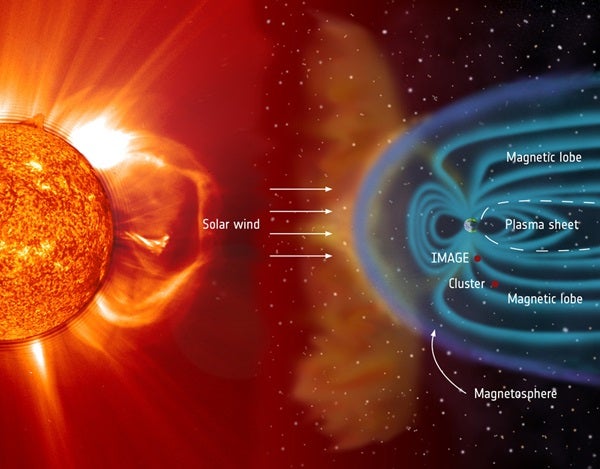The diagram labels by two red dots is the location of an ESA Cluster satellite and NASA’s Image satellite on September 15, 2005, when particular conditions of the magnetic field configuration gave rise to a phenomenon known as “theta aurora”.
Although separated by some 90 million miles (150 million kilometers), the Sun and Earth are connected by the solar wind. This stream of plasma — electrically charged atomic particles — is launched by the Sun and travels across the solar system, carrying its own magnetic field with it.
Depending on how this “interplanetary magnetic field” is aligned with Earth’s magnetic field when it arrives, there can be various results.
At the point where the two fields meet, Earth’s magnetic field points north. If the interplanetary field is pointing south, then “magnetic reconnection” can occur —magnetic field lines pointing in opposite directions spontaneously break and reconnect with other nearby field lines.
This opens the door to solar wind plasma entering the magnetosphere — Earth’s magnetic “bubble.”
The ultimate result can be colorful displays in the night sky known as the northern or southern lights, produced when the particles are channeled along Earth’s magnetic field lines and strike atoms high in the atmosphere.
The interaction with oxygen atoms results in a green or, more rarely, red glow in the night sky while nitrogen atoms yield blue and purple colors.
Normally, the main region for this impressive display is the “auroral oval,” which lies at around 65–70° north or south of the equator, encircling the polar caps.
But when the interplanetary magnetic field points northward, aurorae can occur at even higher latitudes. One type is known as a “theta aurora” because seen from above it looks like the Greek letter theta — an oval with a line crossing through the center.
While the genesis of the auroral oval emissions is reasonably well understood, the origin of the theta aurora was unclear until now.
A clue comes from the particles observed in the two “lobe” regions of the magnetosphere. The plasma in the lobes is normally cold, but previous observations suggested that theta aurorae are linked with unusually hot lobe plasma, though quite how was unclear.
“The possibilities have been debated since the first satellite observations of the phenomenon were made in the 1980s,” said Robert Fear of the University of Southampton in the United Kingdom.
“Previously, it was unclear whether this hot plasma was a result of direct solar wind entry through the lobes of the magnetosphere or if the plasma is somehow related to the plasma sheet on the night side of Earth.
“One idea is that the process of magnetic reconnection on the night side of Earth causes a buildup of ‘trapped’ hot plasma in the higher latitude lobes.”
The mystery was finally solved by studying data collected simultaneously by the Cluster and Image satellites September 15, 2005. While the four Cluster satellites were located in the Southern Hemisphere magnetic lobe, Image had a wide-field view of the Southern Hemisphere aurora. As one Cluster satellite observed uncharacteristically energetic plasma in the lobe, Image saw the “arc” of the theta aurora cross the magnetic footprint of Cluster.
“We found that the energetic plasma signatures occur on high-latitude magnetic field lines that have been closed by the process of magnetic reconnection, which then causes the plasma to become relatively hot,” said Fear.
“Because the field lines are closed, the observations are incompatible with direct entry from the solar wind. By testing this and other predictions about the behavior of the theta aurora, our observations provide strong evidence that the plasma-trapping mechanism is responsible for the theta aurora.”
“The study highlights the intriguing process that can occur in the magnetosphere when the interplanetary magnetic field of the solar wind points northwards,” said Philippe Escoubet from ESA.
“This is the first time that the origin of the theta aurora phenomenon has been revealed, and it is thanks to localized measurements from Cluster combined with the wide-field view of Image that we can better understand another aspect of the Sun-Earth connection.”










